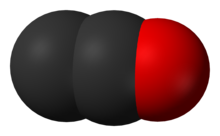Dicarbon monoxide
Appearance

| |

| |

| |
| Names | |
|---|---|
| IUPAC name
2-oxoethenylidene
| |
| Identifiers | |
3D model (JSmol)
|
|
CompTox Dashboard (EPA)
|
|
| |
| Properties | |
| Molar mass | 40.02 g mol−1 |
Except where otherwise noted, data are given for materials in their standard state (at 25 °C [77 °F], 100 kPa).
| |
Dicarbon monoxide (C2O) is an extremely reactive molecule that contains two carbon atoms and one oxygen atom. Dicarbon monoxide, covalently bonded, is a product of the photolysis of carbon suboxide.[1][2] It is closely related to CO, CO2 and C3O2, and other oxocarbons.
- C3O2 → CO + C2O
It is stable enough to observe reactions with NO and NO2.[3]
References
- ^ Bayes K. (1961). "Photolysis of Carbon Suboxide". Journal of the American Chemical Society. 83: 3712–3713. doi:10.1021/ja01478a033.
- ^ Anderson D. J., Rosenfeld R. N. (1991). "Photodissociation of Carbon Suboxide". Journal of Chemical Physics. 94: 7852–7867. doi:10.1063/1.460121.
- ^ Thweatt W. D., Erickson M. A., Hershberger J. F. (2004). "Kinetics of the CCO+NO and CCO+NO2 reactions". Journal of Physical Chemistry. 108: 74–79. doi:10.1021/jp0304125.
{{cite journal}}: CS1 maint: multiple names: authors list (link)
